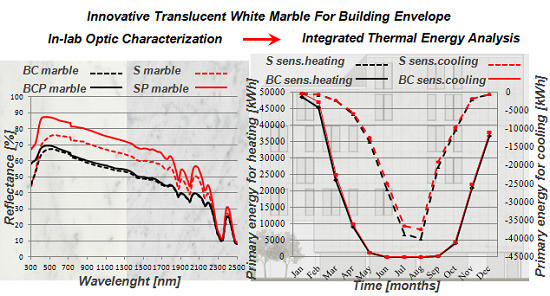Integrated Thermal-Energy Analysis of Innovative Translucent White Marble for Building Envelope Application
Abstract
:1. Introduction
2. Research Background and Purpose of the Work
3. Materials and Methods
3.1. Research Procedure
- Choice of the materials: two white marbles, similar in color and finishing, are chosen as prototypes for the experimental characterization and the following thermal-energy dynamic simulation;
- Marble in-lab characterization: the chosen samples are characterized through measuring their superficial optic-energy main properties, such as solar reflectance and thermal emissivity;
- Comparative statistical analysis;
- Development of the building thermal-energy model: the dynamic simulation model at the design stage of a multipurpose building is carried out;
- Thermal-energy analysis of the effect of marble facades in both free-floating conditions and controlled temperature set point conditions;
- Analysis of the main results.
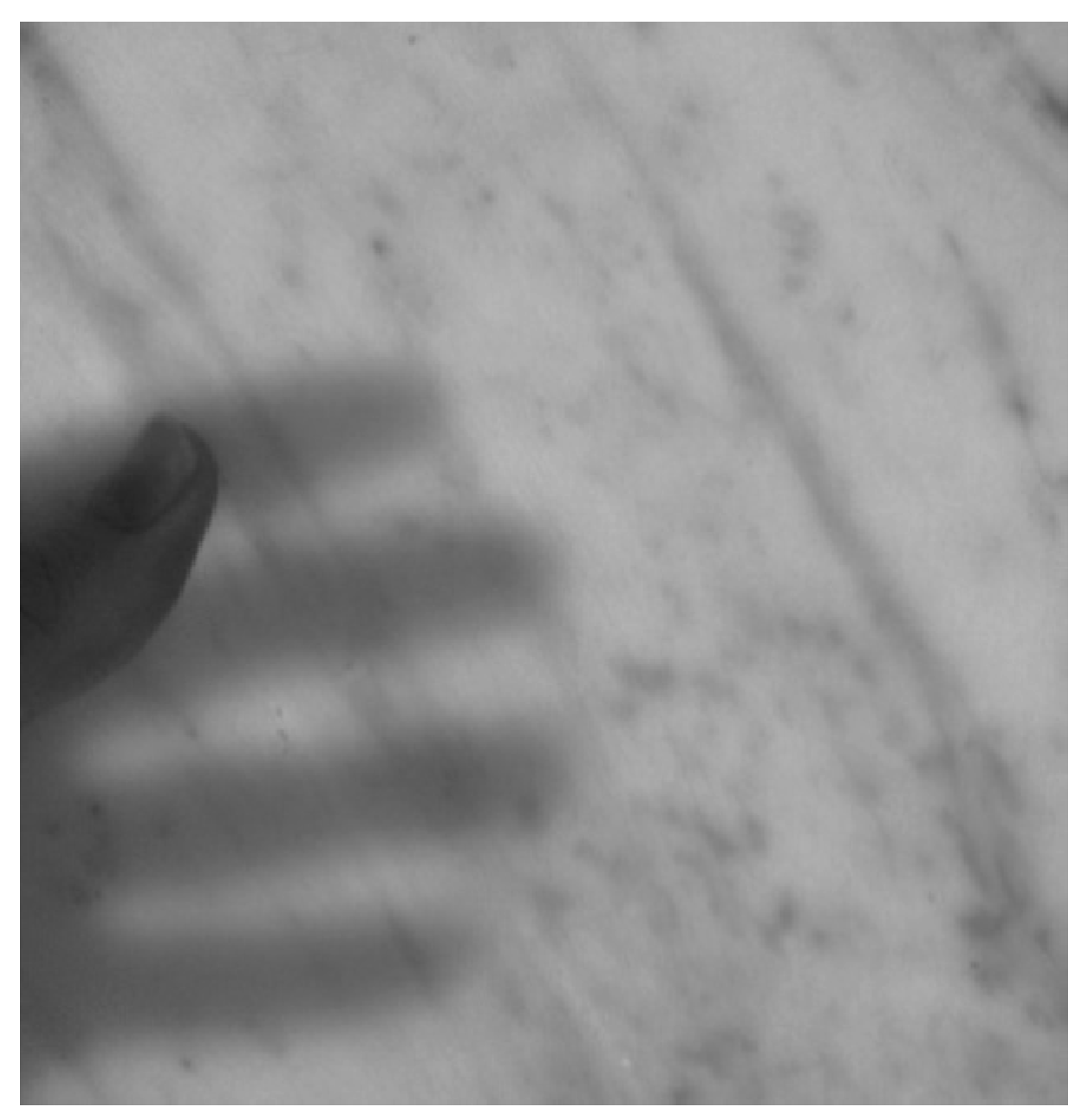

3.2. Marble Characterization
| Measured Value | Marble Typology | |
|---|---|---|
| Bianco Carrara Polished (BCP) | Statuario Polished (SP) | |
| Emissivity | 0.83 | 0.88 |
| Solar Transmittance (%) | 7.4 | 4.4 |
| Absorbance (%) | 34.4 | 14.8 |
| Measured Value | Marble Typology | |||
|---|---|---|---|---|
| Bianco Carrara (BC) | Statuario (S) | Bianco Carrara Polished (BCP) | Statuario Polished (SP) | |
| Solar Reflectance [%] | 58.4 | 73.7 | 59.0 | 79.2 |
| UV | 53.0 | 60.9 | 62.7 | 73.1 |
| Vis | 63.5 | 78.6 | 66.5 | 85.1 |
| NIR | 69.0 | 78.6 | 70.2 | 54.1 |

3.3. Marble Statistical Comparison
4. Case Study Building
4.1. Architecture
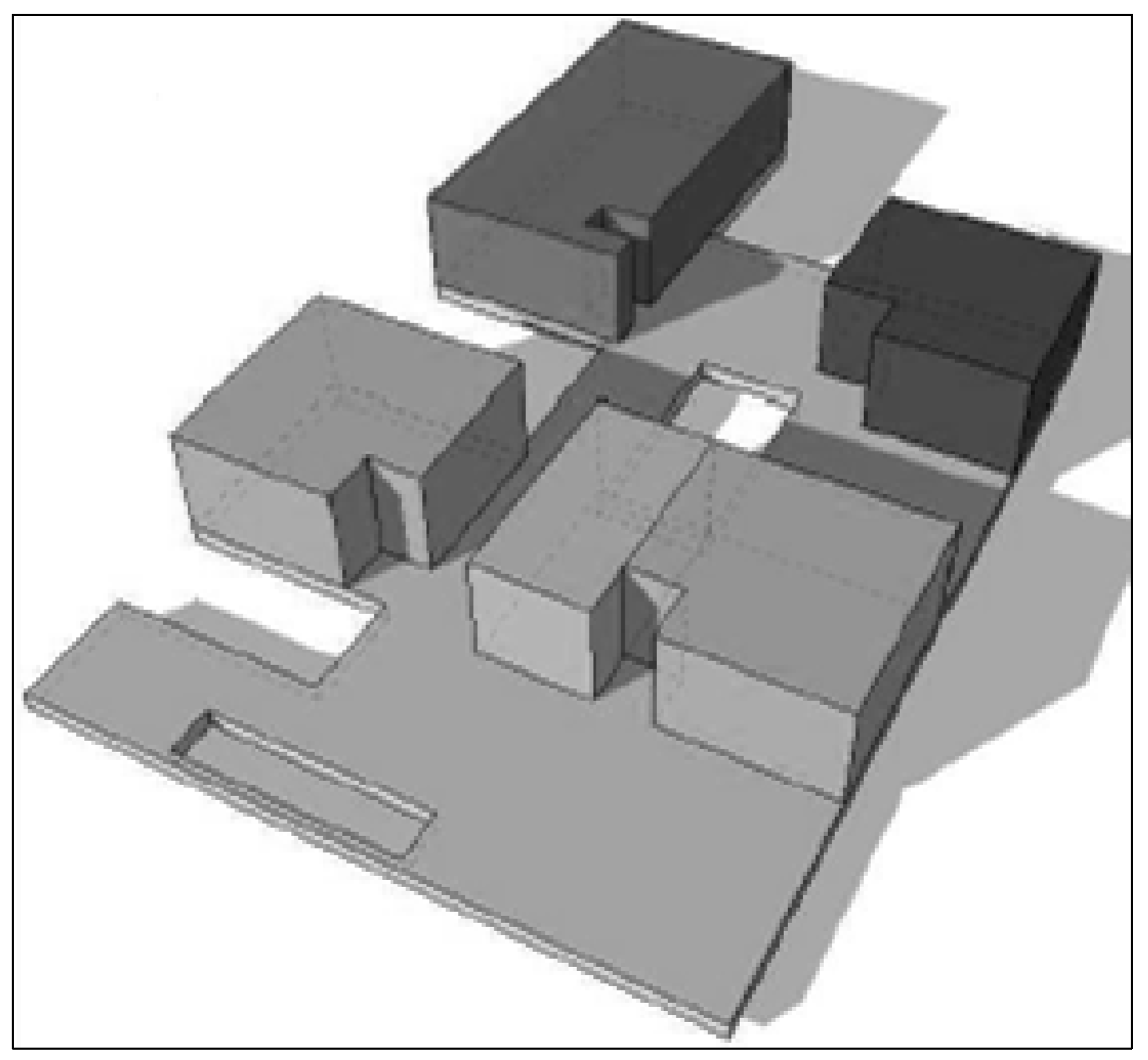
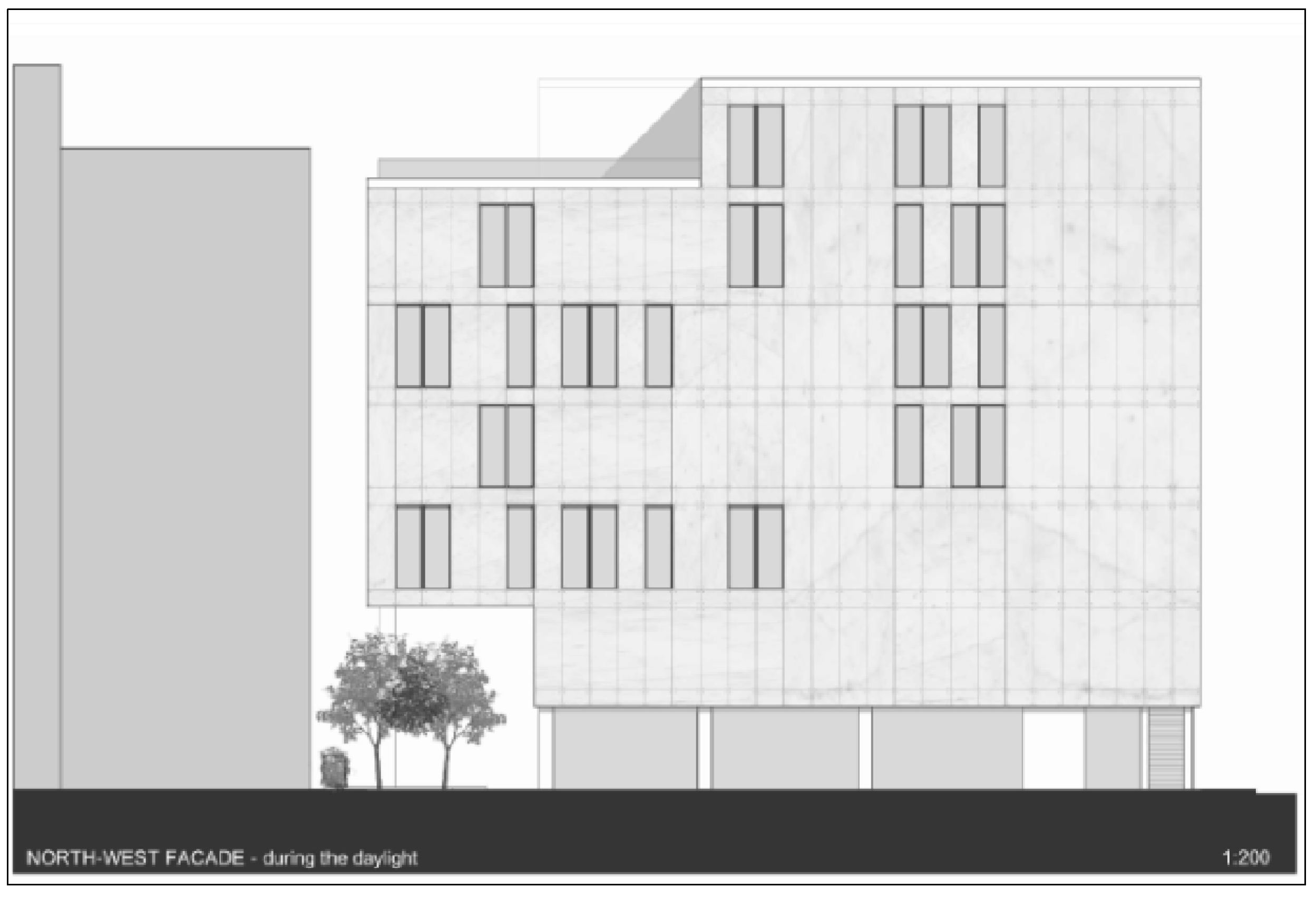

4.2. Physical Characterization of the Building
| Thermal Zone | Characteristics |
|---|---|
| 1. Hall, lecture theatre | Density: 0.2 people/m2 |
| Activity-metabolic rate: standing-walking 140 W/person | |
| Target illuminance: 300 lux | |
| Equipment gain: 2 W/m2, radiant fraction 20% | |
| Schedule: from 8:00 am to 6:00 pm, 7 days/week | |
| 2. Display and public areas | Density: 0.15 people/m2 |
| Activity-metabolic rate: light manual work 180 W/person | |
| Target illuminance: 200 lux | |
| Equipment gain: 2 W/m2, radiant fraction 20% | |
| Schedule: from 8:00 am to 6:00 pm, Sunday off | |
| 3. Domestic dining room | Density: 0.17 people/m2 |
| Activity-metabolic rate: eating-drinking 110 W/person | |
| Target illuminance: 150 lux | |
| Equipment gain: 3 W/m2, radiant fraction 20% | |
| Schedule: from 8:00 am to 1:00 pm and from 6:00 pm to 9:00 pm, 7 days/week | |
| 4. Domestic kitchen | Density: 0.05 people/m2 |
| Activity-metabolic rate: light work 160 W/person | |
| Target illuminance: 300 lux | |
| Equipment gain: 30 W/m2, radiant fraction 20% | |
| Schedule: from 8:00 am to 1:00 pm and from 6:00 pm to 9:00 pm, 7 days/week | |
| 5. Museum galleries | Density: 0.05 people/m2 |
| Activity-metabolic rate: light work 160 W/person | |
| Target illuminance: 300 lux | |
| Equipment gain: 30 W/m2, radiant fraction 20% | |
| Schedule: from 8:00 am to 1:00 pm and from 6:00 pm to 9:00 pm, 7 days/week |
| WMO Station Identifier 744860 Details: TMY3 | Latitude: 40.65; Longitude: −73.80 | |||||||||||
|---|---|---|---|---|---|---|---|---|---|---|---|---|
| Jan | Feb | Mar | Apr | May | Jun | Jul | Aug | Sep | Oct | Nov | Dec | |
| Outside Dry-Bulb Temperature (°C) | 1.17 | −0.17 | 5.58 | 10.94 | 16.05 | 21.71 | 25.05 | 24.79 | 19.95 | 14.02 | 7.31 | 3.32 |
| Wind Speed (m/s) | −4.35 | −7.45 | 0.29 | 4.75 | 9.14 | 15.84 | 20.26 | 17.15 | 13.23 | 7.95 | 2.14 | −2.82 |
| Wind Speed (m/s) | 5.64 | 5.07 | 5.58 | 4.99 | 4.42 | 4.92 | 4.06 | 4.19 | 3.91 | 4.86 | 5.61 | 5.64 |
| Direct Normal Solar (kWh) | 66.5 | 92.7 | 115.2 | 117.1 | 129.5 | 134.4 | 128.8 | 168.7 | 120.1 | 134.3 | 65.6 | 74.5 |
| Diffuse Horizontal Solar (kWh) | 27.6 | 31.7 | 51.0 | 59.7 | 81.5 | 81.0 | 85.3 | 71.4 | 53.2 | 45.8 | 34.8 | 22.7 |
| S/BC Marble Vertical Envelope | Flat Roof | ||||
|---|---|---|---|---|---|
| Material | Thickness | Material | Thickness | ||
| S/BC marble layer | 0.01 m | Asphalt membrane | 0.01 m | ||
| Epoxy resin | 0.005 m | Mineral wood rolls | 0.14 m | ||
| Quartz glass | 0.015 m | Air gap | 0.03 m | ||
| Air gap | 0.25 m | Plasterboard | 0.02 m | ||
| Internal glass panel | 0.02 m | Cement slab | 0.2 m | ||
| Thermal transmittance: 2.6 W/m2K | Thermal transmittance: 0.2 W/m2K | ||||
| Internal heat capacity: 33 kJ/m2K | Internal heat capacity: 189 kJ/m2K | ||||
| Ground Floor | Ground Floor | ||||
| Material | Thickness | Material | Thickness | ||
| XPS insulating panel | 0.09 m | Gypsum plasterboard | 0.025 m | ||
| Cast concrete | 0.20 m | Air gap | 0.10 m | ||
| Floor screed | 0.07 m | Gypsum plasterboard | 0.025 m | ||
| Thermal transmittance: 0.3 W/m2K | Thermal transmittance: 1.6 W/m2K | ||||
| Internal heat capacity: 97 kJ/m2K | Internal heat capacity: 23 kJ/m2K | ||||
5. Results and Discussion
5.1. Marble In-Lab Analysis and Statistical Observations
5.1.1. Solar Reflection Index (SRI), UV, Visible (Vis) and Near-Infrared Reflectance (NIR)
- Bianco Carrara (BC) and Statuario (S) marbles;
- Bianco Carrara polished (BCP) and Statuario polished (SP);
- Bianco Carrara (BC) and Bianco Carrara polished (BCP);
- Statuario (S) and Statuario polished (SP);
5.1.1.1. Bianco Carrara (BC) and Statuario (S)
| Marble Type | Solar Reflectance | |||
|---|---|---|---|---|
| Mean | SD | Min | Max | |
| BC | 58.7 | 3.1 | 52.7 | 61.0 |
| S | 75.6 | 2.9 | 69.7 | 77.3 |
| Marble Type | Statistical Comparison | |||
| Mean Difference | P>t | Prob>F | R-squared | |
| BC on S | −16.9 | 0.0 | 0.0 | 0.92 |
| Marble Type | UV Reflectance | |||
| Mean | SD | Min | Max | |
| BC | 52.8 | 3.3 | 47.4 | 55.8 |
| S | 61.6 | 2.6 | 56.3 | 63.2 |
| Marble Type | Statistical Comparison | |||
| Mean Difference | P>t | Prob>F | R-squared | |
| BC on S | −8.8 | 0.0 | 0.0 | 0.72 |
| Marble Type | Vis Reflectance | |||
| Mean | SD | Min | Max | |
| BC | 63.9 | 3.6 | 57.1 | 66.6 |
| S | 80.3 | 2.9 | 74.4 | 82.1 |
| Marble Type | Statistical Comparison | |||
| Mean Difference | P>t | Prob>F | R-squared | |
| BC on S | −16.4 | 0.0 | 0.0 | 0.90 |
| Marble Type | NIR Reflectance | |||
| Mean | SD | Min | Max | |
| BC | 53.2 | 2.8 | 47.5 | 55.1 |
| S | 70.0 | 2.6 | 64.7 | 71.4 |
| Marble Type | Statistical Comparison | |||
| Mean Difference | P>t | Prob>F | R-squared | |
| BC on S | −16.8 | 0.0 | 0.0 | 0.93 |
 .
.5.1.1.2. Bianco Carrara Polished (BCP) and Statuario Polished (SP)
| Marble Type | Solar Reflectance | |||
|---|---|---|---|---|
| Mean | SD | Min | Max | |
| BCP | 59.5 | 1.7 | 57.5 | 61.8 |
| SP | 78.8 | 0.4 | 78.4 | 79.6 |
| Marble Type | Statistical Comparison | |||
| Mean Difference | P>t | Prob>F | R-squared | |
| BCP on SP | −19.3 | 0.0 | 0.0 | 0.99 |
| Marble Type | UV Reflectance | |||
| Mean | SD | Min | Max | |
| BCP | 61.1 | 1.9 | 58.9 | 63.0 |
| SP | 71.8 | 1.4 | 70.4 | 73.7 |
| Marble Type | Statistical Comparison | |||
| Mean Difference | P>t | Prob>F | R-squared | |
| BCP on SP | −10.8 | 0.0 | 0.0 | 0.99 |
| Marble Type | Vis Reflectance | |||
| Mean | SD | Min | Max | |
| BCP | 64.0 | 3.0 | 60.6 | 67.4 |
| SP | 84.5 | 0.7 | 83.8 | 85.3 |
| Marble Type | Statistical Comparison | |||
| Mean Difference | P>t | Prob>F | R-squared | |
| BCP on SP | −20.5 | 0.0 | 0.0 | 0.99 |
| Marble Type | NIR Reflectance | |||
| Mean | SD | Min | Max | |
| BCP | 62.0 | 9.5 | 52.7 | 71.0 |
| SP | 63.1 | 9.9 | 53.9 | 72.6 |
| Marble Type | Statistical Comparison | |||
| Mean Difference | P>t | Prob>F | R-squared | |
| BCP on SP |  | 0.9 | 1.0 | 0.00 |
 .
.5.1.1.3. Bianco Carrara (BC) and Bianco Carrara Polished (BCP)
| Marble Type | Solar Reflectance | |||
|---|---|---|---|---|
| Mean | SD | Min | Max | |
| BCP | 59.5 | 1.7 | 57.5 | 61.8 |
| BC | 58.7 | 3.1 | 52.7 | 61.0 |
| Marble Type | Statistical Comparison | |||
| Mean Difference | P>t | Prob>F | R-squared | |
| BCP on BC |  | 0.6 | 0.3 | 0.73 |
| Marble Type | UV Reflectance | |||
| Mean | SD | Min | Max | |
| BCP | 61.1 | 1.9 | 58.9 | 63.0 |
| BC | 52.8 | 3.3 | 47.4 | 55.8 |
| Marble Type | Statistical Comparison | |||
| Mean Difference | P>t | Prob>F | R-squared | |
| BCP on BC | +8.2 | 0.0 | 0.0 | 0.77 |
| Marble Type | Vis Reflectance | |||
| Mean | SD | Min | Max | |
| BCP | 64.0 | 3.0 | 60.6 | 67.4 |
| BC | 63.9 | 3.6 | 57.1 | 66.6 |
| Marble Type | Statistical Comparison | |||
| Mean difference | P>t | Prob>F | R-squared | |
| BCP on BC |  | 1.0 | 0.6 | 0.12 |
| Marble Type | NIR Reflectance | |||
| Mean | SD | Min | Max | |
| BCP | 62.0 | 9.5 | 52.7 | 71.0 |
| BC | 53.2 | 2.8 | 47.5 | 55.1 |
| Marble Type | Statistical Comparison | |||
| Mean Difference | P>t | Prob>F | R-squared | |
| BCP on BC | +8.7 | 0.0 | 0.0 | 0.55 |
 .
.5.1.1.4. Statuario (S) and Statuario Polished (SP)
| Marble Type | Solar Reflectance | |||
|---|---|---|---|---|
| Mean | SD | Min | Max | |
| SP | 78.8 | 0.4 | 78.4 | 79.6 |
| SP | 75.6 | 2.9 | 69.7 | 77.3 |
| Marble Type | Statistical Comparison | |||
| Mean Difference | P>t | Prob>F | R-squared | |
| SP on S | +3.2 | 0.0 | 0.1 | 0.48 |
| Marble Type | UV Reflectance | |||
| Mean | SD | Min | Max | |
| SP | 71.8 | 1.4 | 70.4 | 73.7 |
| SP | 61.6 | 2.6 | 56.3 | 63.2 |
| Marble Type | Statistical Comparison | |||
| Mean Difference | P>t | Prob>F | R-squared | |
| SP on S | +10.2 | 0.0 | 0.0 | 0.88 |
| Marble Type | Vis Reflectance | |||
| Mean | SD | Min | Max | |
| SP | 84.5 | 0.7 | 83.8 | 85.3 |
| SP | 80.3 | 2.9 | 74.4 | 82.1 |
| Marble Type | Statistical Comparison | |||
| Mean Difference | P>t | Prob>F | R-squared | |
| SP on S | +4.2 | 0.0 | 0.0 | 0.57 |
| Marble Type | NIR Reflectance | |||
| Mean | SD | Min | Max | |
| SP | 63.1 | 9.9 | 53.9 | 72.6 |
| SP | 70.0 | 2.6 | 64.7 | 71.4 |
| Marble Type | Statistical Comparison | |||
| Mean Difference | P>t | Prob>F | R-squared | |
| SP on S | −6.9 | 0.0 | 0.0 | 0.65 |
 .
.5.1.2. Solar Transmittance
| Marble Type | Transmittance | |||
|---|---|---|---|---|
| Mean | SD | Min | Max | |
| BCP | 8.3 | 1.4 | 6.0 | 9.5 |
| SP | 4.2 | 0.3 | 3.8 | 4.7 |
| Marble Type | Statistical Comparison | |||
| Mean Difference | P>t | Prob>F | R-squared | |
| BCP on SP | +4.1 | 0.0 | 0.0 | 0.85 |
 .
.5.1.3. Solar Absorbance
| Marble Type | Absorbance | |||
|---|---|---|---|---|
| Mean | SD | Min | Max | |
| BCP | 31.7 | 3.7 | 27.3 | 36.7 |
| SP | 15.6 | 1.0 | 14.5 | 16.8 |
| Marble Type | Statistical Comparison | |||
| Mean Difference | P>t | Prob>F | R-squared | |
| BCP on SP | +16.1 | 0.0 | 0.0 | 0.93 |
 .
.5.1.4. Color Rendering Index
| Marble Type | Color Rendering Index | |||
|---|---|---|---|---|
| Mean | SD | Min | Max | |
| BCP | 85.8 | 1.2 | 84.0 | 87.0 |
| SP | 85.7 | 3.1 | 81.0 | 89.0 |
| Marble Type | Statistical Comparison | |||
| Mean Difference | P>t | Prob>F | R-squared | |
| BCP on SP |  | 0.9 | 0.5 | 0.13 |
 .
.5.2. Building Thermal Analysis
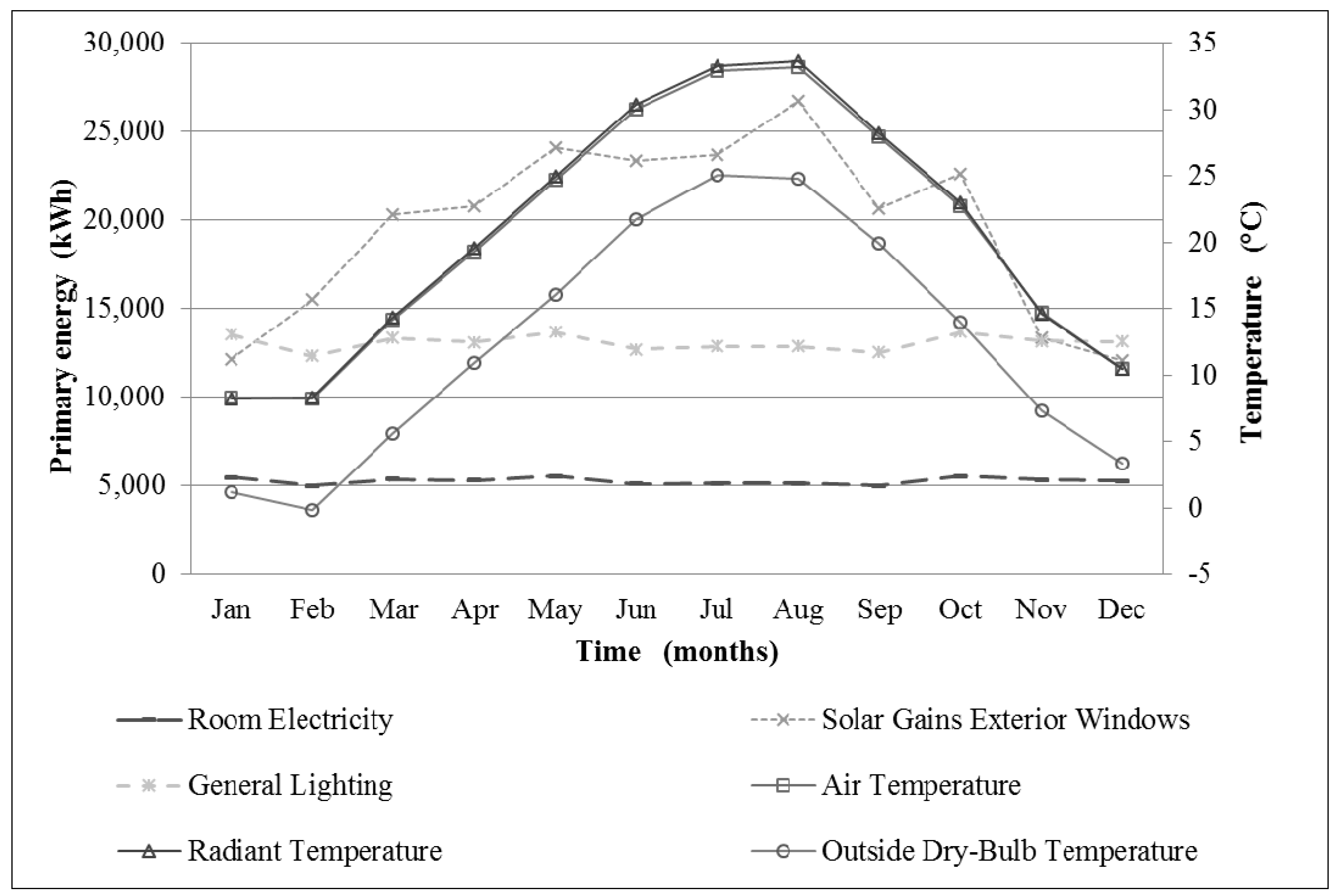
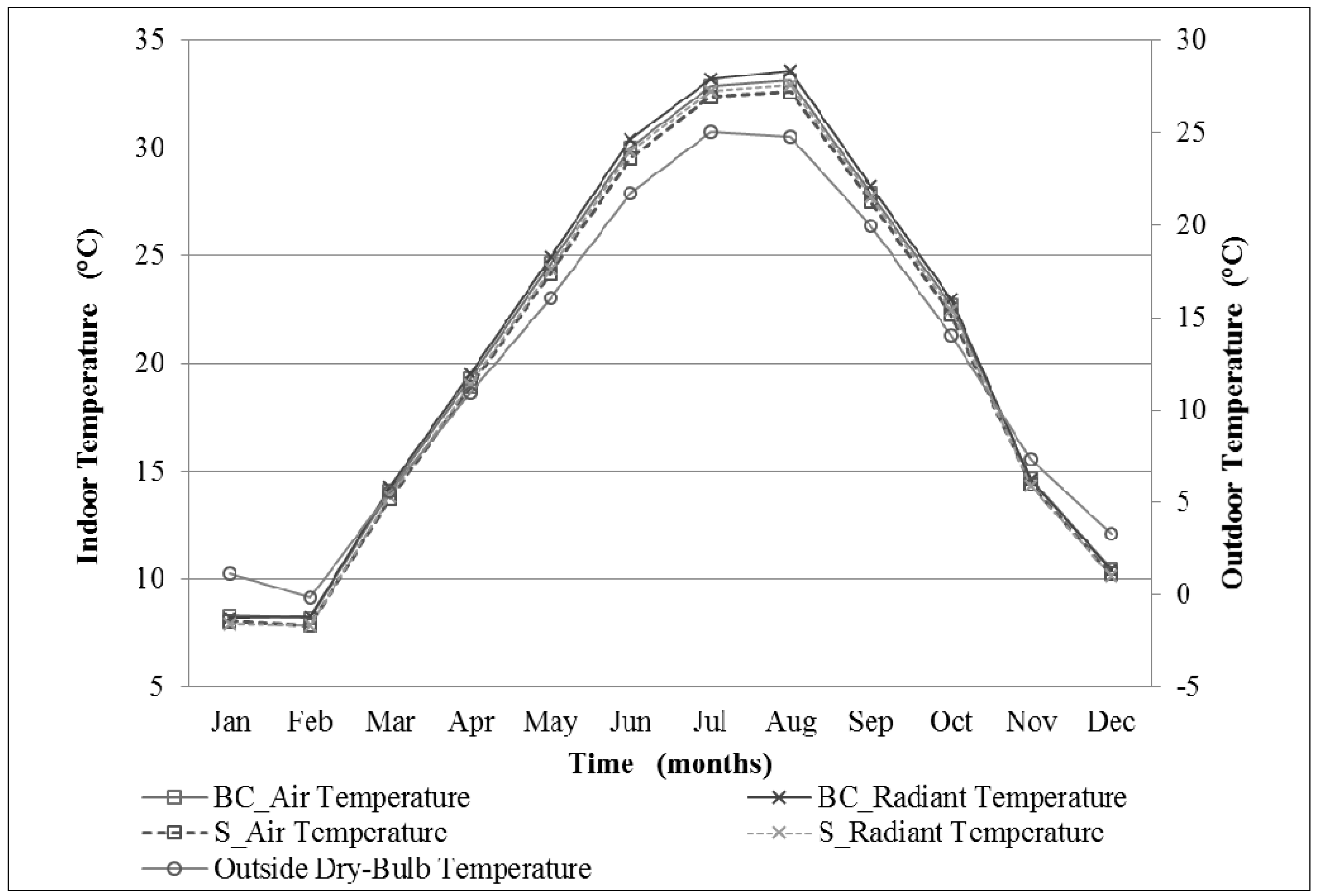
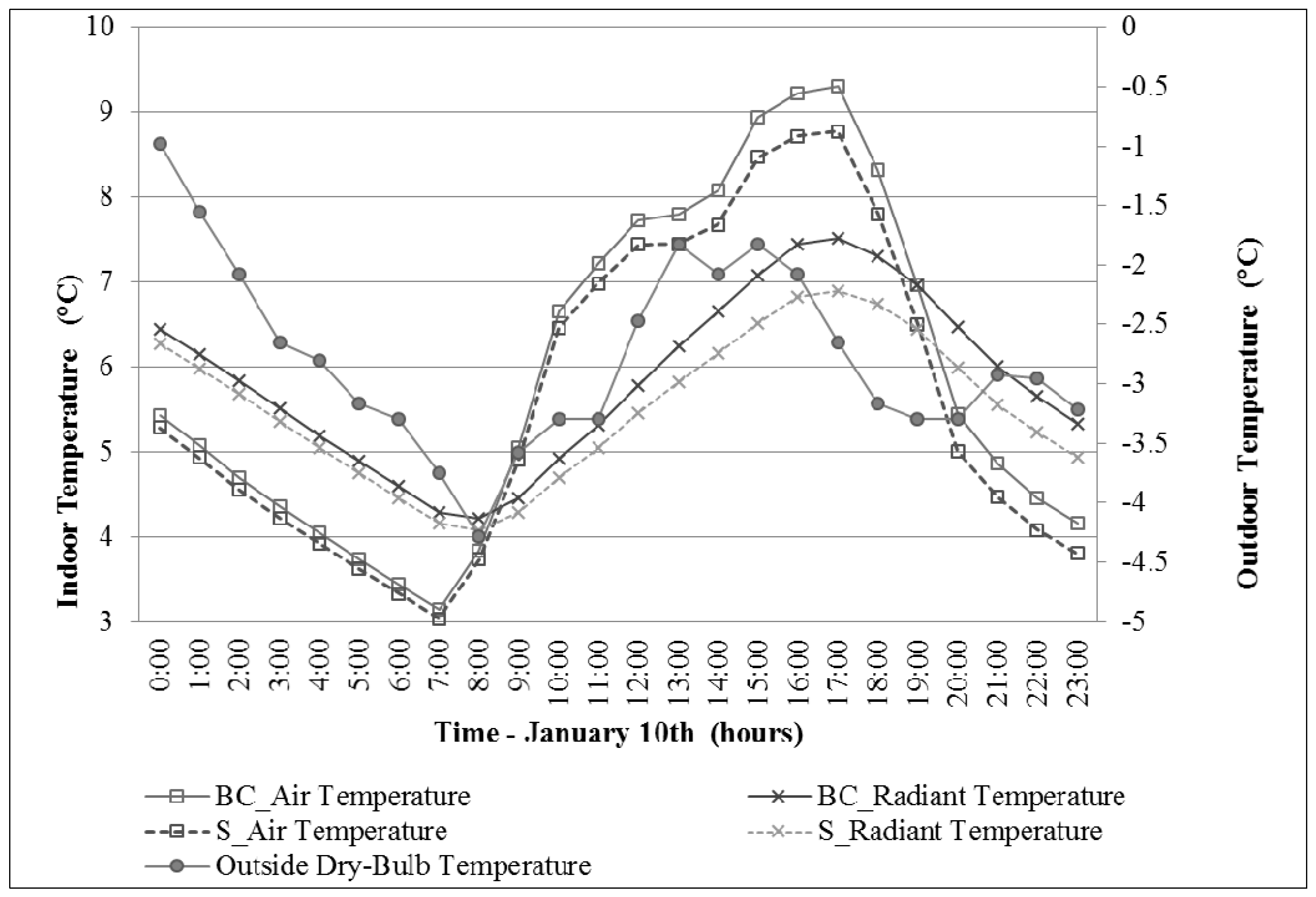
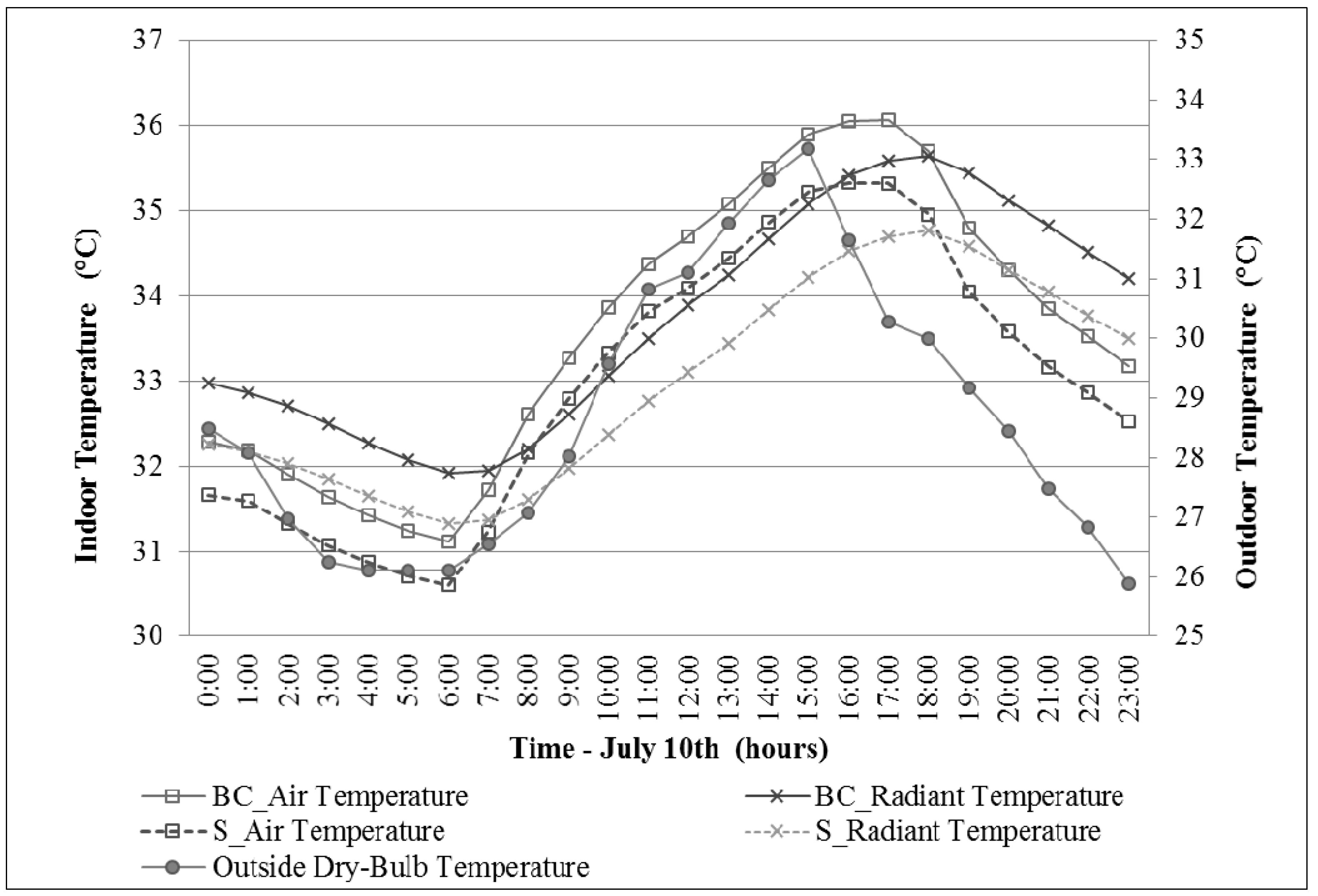
5.3. Building Energy Analysis
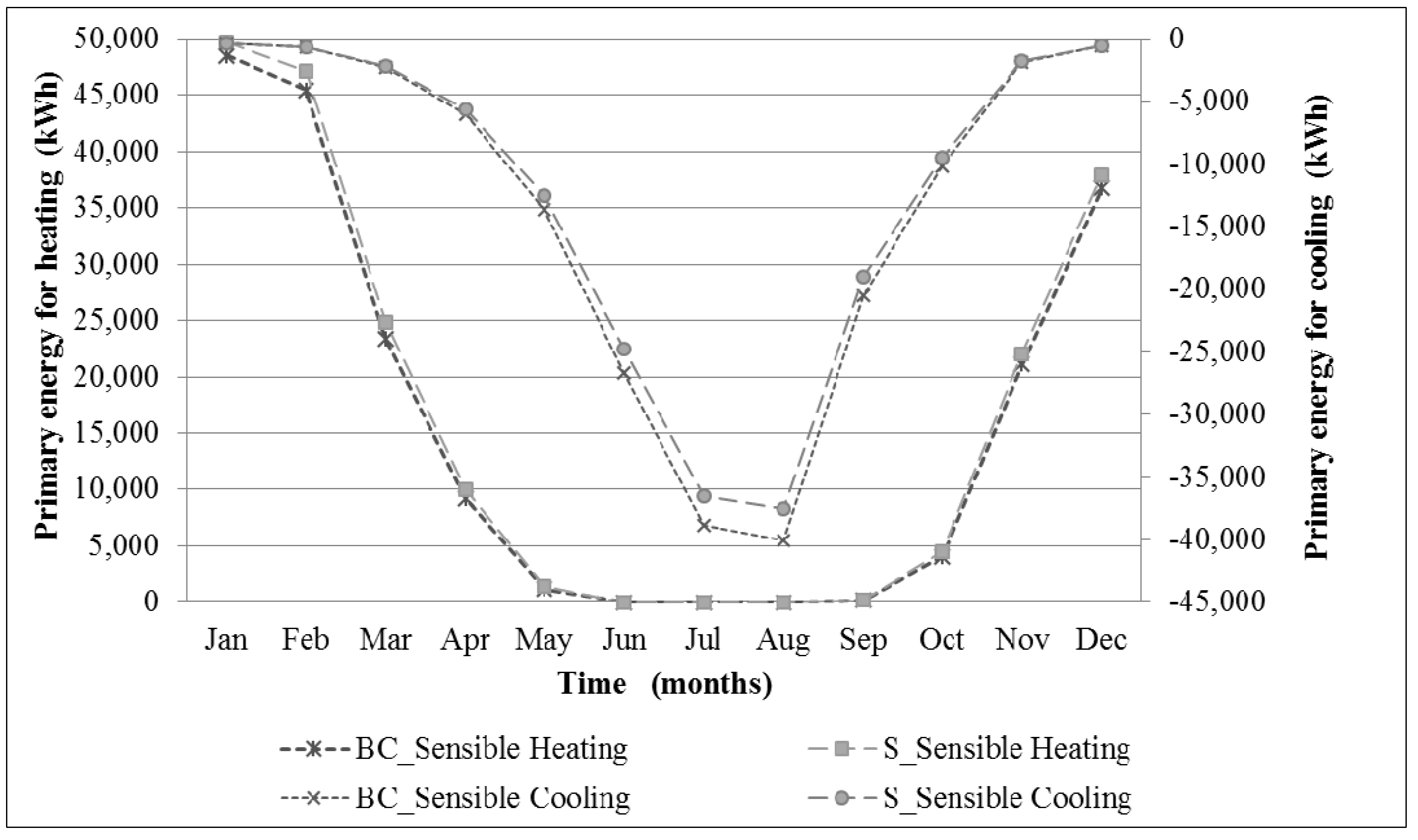
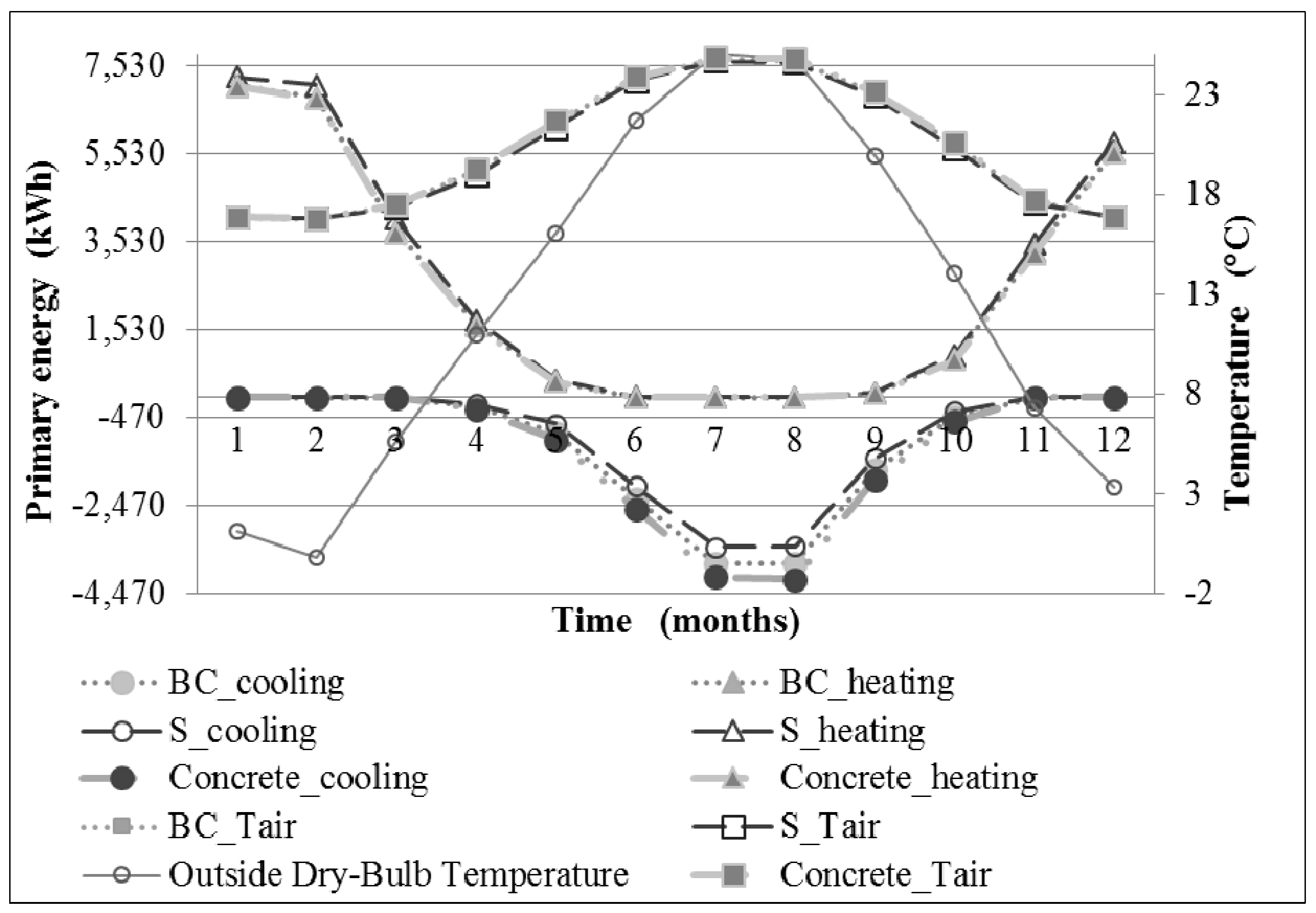
6. Conclusions and Future Developments
Acknowledgments
Author Contributions
Conflicts of Interest
References
- European Commission. Horizon 2020, the EU Framework Programme for Research and Innovation. Available online: http://ec.europa.eu/programmes/horizon2020/ (accessed on 14 August 2014).
- IEA, International Energy Agency. Available online: http://www.iea.org/ (accessed on 28 February 2014).
- Pisello, A.L.; Goretti, M.; Cotana, F. A method for assessing buildings’ energy efficiency by dynamic simulation and experimental activity. Appl. Energy 2012, 97, 419–429. [Google Scholar] [CrossRef]
- Cotana, F.; Petrozzi, A.; Pisello, A.L.; Coccia, V.; Cavalaglio, G.; Moretti, E. An innovative small sized anaerobic digester in historic building. Proceedings of the 68th Conference of Italan Thermal Machines Engineering Association, Bologna, Italy, 11–13 September 2013. Energy Procedia 2014, 45, 333–341. [Google Scholar] [CrossRef]
- Rizwan, A.M.; Dennis, Y.C.L.; Liu, C. A review on the generation, determination and mitigation of Urban Heat Island. J. Environ. Sci. 2008, 20, 120–128. [Google Scholar] [CrossRef]
- Bouchlaghem, N. Optimizing the design of building envelopes for thermal performance. Autom. Constr. 2000, 10, 101–112. [Google Scholar] [CrossRef]
- Sozer, H. Improving energy efficiency through the design of the building envelope. Build. Environ. 2010, 45, 2581–2593. [Google Scholar] [CrossRef]
- Kolokotsa, D.; Maravelaki-Kalaitzaki, P.; Papantoniou, S.; Vangeloglou, E.; Saliari, M.; Karlessi, T.; Santamouris, M. Development and analysis of mineral based coatings for buildings and urban structures. Sol. Energy 2012, 86, 1648–1659. [Google Scholar] [CrossRef]
- Transient System Simulation Tool. Available online: www.trnsys.com (accessed on 20 June 2014).
- Moretti, E.; Zinzi, M.; Belloni, E. Polycarbonate panels for buildings: Experimental investigation of thermal and optical performance. Energy Build. 2013, 67, 210–216. [Google Scholar] [CrossRef]
- Pisello, A.L.; Cotana, F. The thermal effect of an innovative cool roof on residential buildings in Italy: Results from two years of continuous monitoring. Energy Build. 2014, 69, 154–164. [Google Scholar] [CrossRef]
- Boarin, P.; Guglielmino, D.; Pisello, A.L.; Cotana, F. Sustainability Assessment of Historic Buildings: Lesson Learnt from an Italian Case Study through LEED® Rating System. In Proceedings of the 6th International Conference on Applied Energy, Taipei, Taiwan, 30 May–2 June 2014.
- Doulos, L.; Santamouris, M.; Liveda, I. Passive cooling of outdoor urban spaces. The role of materials. Sol. Energy 2004, 77, 231–249. [Google Scholar]
- Doya, M.; Bozonnet, E.; Allard, F. Experimental measurement of cool facades’ performance in a dense urban environment. Energy Build. 2012, 55, 42–50. [Google Scholar]
- Pisello, A.L.; Cotana, F.; Nicolini, A.; Buratti, C. Effect of dynamic characteristics of building envelope on thermal-energy performance in winter conditions: In field experiment. Energy Build. 2014. [Google Scholar] [CrossRef]
- International Organization for Standardization. ISO 6344-3 2013 Coated Abrasives—Grain Size Analysis; International Organization for Standardization: Geneva, Switzerland, 1947. [Google Scholar]
- Shimadzu Excellence in Science. Available online: http://www.ssi.shimadzu.com/products/product.cfm?product=solidspec (accessed on 1 March 2014).
- American Society for Testing Materials. ASTM E 903-96 Standard Test Method for Solar Absorptance, Reflectance, and Transmittance of Materials Using Integrating Spheres; American Society for Testing Materials: West Conshohocken, PA, USA, 1996. [Google Scholar]
- Devices and Services. Available online: http://www.devicesandservices.com/prod03.htm (accessed on 1 March 2014).
- American Society for Testing Materials. ASTM C1371-04a(2010)e1 Standard Test Method for Determination of Emittance of Materials Near Room Temperature Using Portable Emissometers; American Society for Testing Materials: West Conshohocken, PA, USA, 2010. [Google Scholar]
- STATA. Data Analysis and Statistical Software. Available online: http://www.stata.com/ (accessed on 1 March 2014).
- Xu, X.; Taylor, J.E.; Pisello, A.L. Network synergy effect: Establishing a synergy between building network and peer network energy conservation effects. Energy Build. 2014, 68, 312–320. [Google Scholar] [CrossRef]
- Pisello, A.L.; Castaldo, V.L.; Taylor, J.E.; Cotana, F. Expanding Inter-Building Effect Modeling to Examine Primary Energy for Lighting. Energy Build. 2014, 76, 513–523. [Google Scholar] [CrossRef]
- CEN. UNI EN 15251. In Indoor Environmental Input Parameters for Design and Assessment of Energy Performance of Buildings Addressing Indoor Air Quality, Thermal Environment, Lighting and Acoustics; CEN: Brussels, Belgium, 2008. [Google Scholar]
- Pisello, A.L.; Santamouris, M.; Cotana, F. Active cool roof effect: Impact of cool roofs on cooling system efficiency. Adv. Build. Energy Res. 2013, 7, 209–221. [Google Scholar] [CrossRef]
- EnergyPlus, the Official Building Simulation Program of the United States Department of Energy. Available online: http:/www.eere.energy.gov/buildings/ (accessed on 7 March 2014).
© 2014 by the authors; licensee MDPI, Basel, Switzerland. This article is an open access article distributed under the terms and conditions of the Creative Commons Attribution license (http://creativecommons.org/licenses/by/3.0/).
Share and Cite
Rosso, F.; Pisello, A.L.; Cotana, F.; Ferrero, M. Integrated Thermal-Energy Analysis of Innovative Translucent White Marble for Building Envelope Application. Sustainability 2014, 6, 5439-5462. https://doi.org/10.3390/su6085439
Rosso F, Pisello AL, Cotana F, Ferrero M. Integrated Thermal-Energy Analysis of Innovative Translucent White Marble for Building Envelope Application. Sustainability. 2014; 6(8):5439-5462. https://doi.org/10.3390/su6085439
Chicago/Turabian StyleRosso, Federica, Anna Laura Pisello, Franco Cotana, and Marco Ferrero. 2014. "Integrated Thermal-Energy Analysis of Innovative Translucent White Marble for Building Envelope Application" Sustainability 6, no. 8: 5439-5462. https://doi.org/10.3390/su6085439






